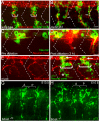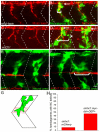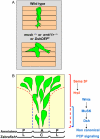A novel role for MuSK and non-canonical Wnt signaling during segmental neural crest cell migration
- PMID: 21750038
- PMCID: PMC3133918
- DOI: 10.1242/dev.067306
A novel role for MuSK and non-canonical Wnt signaling during segmental neural crest cell migration
Abstract
Trunk neural crest cells delaminate from the dorsal neural tube as an uninterrupted sheet; however, they convert into segmentally organized streams before migrating through the somitic territory. These neural crest cell streams join the segmental trajectories of pathfinding spinal motor axons, suggesting that interactions between these two cell types might be important for neural crest cell migration. Here, we show that in the zebrafish embryo migration of both neural crest cells and motor axons is temporally synchronized and spatially restricted to the center of the somite, but that motor axons are dispensable for segmental neural crest cell migration. Instead, we find that muscle-specific receptor kinase (MuSK) and its putative ligand Wnt11r are crucial for restricting neural crest cell migration to the center of each somite. Moreover, we find that blocking planar cell polarity (PCP) signaling in somitic muscle cells also results in non-segmental neural crest cell migration. Using an F-actin biosensor we show that in the absence of MuSK neural crest cells fail to retract non-productive leading edges, resulting in non-segmental migration. Finally, we show that MuSK knockout mice display similar neural crest cell migration defects, suggesting a novel, evolutionarily conserved role for MuSK in neural crest migration. We propose that a Wnt11r-MuSK dependent, PCP-like pathway restricts neural crest cells to their segmental path.
Figures






References
-
- Adams R. H., Diella F., Hennig S., Helmbacher F., Deutsch U., Klein R. (2001). The cytoplasmic domain of the ligand ephrinB2 is required for vascular morphogenesis but not cranial neural crest migration. Cell 104, 57-69 - PubMed
Publication types
MeSH terms
Substances
Grants and funding
LinkOut - more resources
Full Text Sources
Other Literature Sources
Molecular Biology Databases

